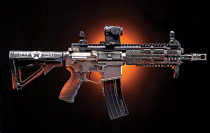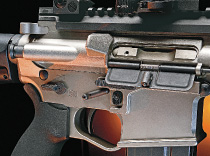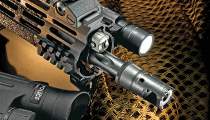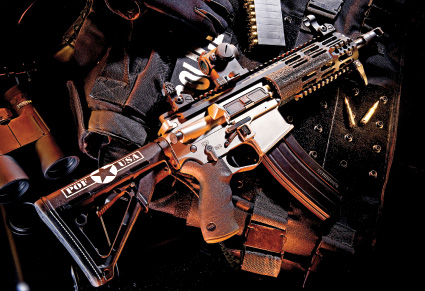For many years now the argument has waged back and forth between 5.56mm and 6.8 SPC. “Which one hits harder, which one is better?” The questions and claims fly back and forth. My two cents on the matter is simply this, I’ve seen some massive wound cavities created with 5.56mm. I’ve personally blown holes through soft-armor clad ballistics dummies using 7.5-inch 5.56mm SBRs. I’ve watched 5.56mm Hornady TAP in 75-grain pierce holes in Level IIIA body armor and blow out sections of ballistics media measuring 5 inches in diameter and another 5 in depth. I know that the heavier rounds in 5.56mm will get the job done quite well. Yet with all this information, I’ll tell you hands down that given the choice to carry a 6.8mm or 5.56mm chambered weapon into the fray, I’d go with 6.8mm any day of the week.
 Anecdotal evidence proves that the current M855 steel cored rounds that our soldiers are being forced to use are tantamount to spitwads in a fight. Don’t misunderstand me on this, M855 is an excellent anti-material round but it acts like a laser beam on people. It goes right through the enemy creating small holes that don’t incapacitate the subject. A gun chambered in 6.8mm on the other hand acts more like an AK-47 firing the always-lethal 7.62mm. The end result is impressive to say the least.
Anecdotal evidence proves that the current M855 steel cored rounds that our soldiers are being forced to use are tantamount to spitwads in a fight. Don’t misunderstand me on this, M855 is an excellent anti-material round but it acts like a laser beam on people. It goes right through the enemy creating small holes that don’t incapacitate the subject. A gun chambered in 6.8mm on the other hand acts more like an AK-47 firing the always-lethal 7.62mm. The end result is impressive to say the least.
I’ve always been a meat and potatoes kind of guy when it comes to weapons. It usually takes the prodding of a friend to get me to look past my small grouping of favorites and accept something new. Upon attending the 2009 SHOT Show I came out of it with two positives. The first was meeting my new friend and photographer Sean Utley, and the second was a new appreciation for POF guns.
Advertisement — Continue Reading Below
Sean is an accomplished photographer but what really caught me was his knowledge of all things gun. Sean is a serious gun guy and has a long-standing history with POF-USA. He introduced me to several folks there at the POF booth, one of whom was a gentleman by the name of Greg Melancon. Greg is the Deputy Director of Military and Law Enforcement Programs for POF-USA. He is part of a two-member team whose purpose it is to meet the small arms needs of U.S. and international military, law enforcement and government agencies. He helps guide R&D to include testing and evaluation of the company’s weapons. He also helps conduct training at the local and government levels, from basic three-day schools to full-blown 21 day advanced urban combat courses. Finally, he ensures that Spec-Ops units have what they need to secure those freedoms that allow us to sleep in our beds at night … . Read between the lines on that one.
Greg was clearly well versed in POF’s product offerings and was happy to walk us through their weapons’ construction and components, which are robust to say the least. I left the POF booth with a greater understanding of how much effort POF puts into their guns. Overbuilt would be a good descriptor of a POF weapon.
 Gun Details
Gun Details
When Greg offered up a new gun for testing in early 2009, I put everything on the back burner and jumped on it. Remembering his name from the show, I knew that the weapon would be substantial. When the box arrived a few days ago, out came the P-415 in 6.8mm, and suddenly felt like I’d stepped in way over my head. This thing is so sweet I don’t even know where to begin. It’s sitting here beside me on the desk as I’m writing this and it’s a sight to behold. First off, the appearance of the thing is truly unique. With the solid, full-length Predator Rail System and its silver, Nickel Teflon NP3 coated skin, it looks like a race gun.
Advertisement — Continue Reading Below
POF makes weapons systems that are 100% made in the USA. That means a lot these days. So it’s no surprise that their stuff reflects American ingenuity at its best. POF tries, whenever possible, to use Mil-Spec parts in their guns. This choice keeps parts commonality with standard AR designs at the forefront and alleviates parts availability issues for the consumer. Where POF weaponry stands out above the crowd is in areas like its lower design. One quickly notices that it’s not exactly Mil-Spec stuff you’re holding. For example, the lower on the P-415 has a beveled magazine well that makes short work of reloads. The triggerguard is machined as part of the lower, adding strength by maintaining a solid uninterrupted assembly. The triggerguard is also machined with a healthy amount of room for gloved fingers. Moving onto the trigger, you quickly find that it too has been given the fine-tooth comb treatment. It’s a Timney!
For those not in “the know,” Timney drop-in, single-stage triggers are smoothness personified. At four pounds, the trigger functions quickly with a deliberate pull without causing undue movement on the weapon. This came in handy during testing. I’ll get to that here shortly.
Relentless Reliability
Heat, carbon, dirt, fouling and lubricant are the enemies of the AR family of weapons. While the aforementioned list is formidable, there is none more dynamic than “lubricant.” Yes lube is indeed the greatest enemy to the AR family. Depending on what conditions your gun operates in, lube can attract contaminants, it can freeze, evaporate, or if your weapon has to go in and out of the water the lube can simply wash away. Most harmful though is the fact that lube attracts the contaminants that stop a gun in the middle of a fight. So by removing the lube from the system you then minimize the chance of the weapon to fail you when you need it most. But without lube, heat quickly takes over and again you’re out of the fight. What’s the solution? One way around the issue is to make metal slick, but once again that comes with a whole host of obstacles as well. The other way is to minimize how much heat, carbon and fouling enter the system. POF has done just that with their piston system: POF’s piston system is comprised of four pieces; the gas plug, piston, block and op-rod. Pistons are a well-known and well-implemented alternative to the direct impingement guns of old. While direct impingement guns still have a purpose, pistons really are better at surviving harsh environments. Case in point, POF uses a metal coating process called “Robar NP3,” or just NP3 for short. This is where that whole “make metal slick”comes in.
Advertisement — Continue Reading Below
NP3 is a surface treatment for steel and metal alloys that combines sub-micron particles of PTFE (polytetrafluoroethylene), or basically Teflon with electroless nickel. “Electroless” means that unlike chrome, which needs an electric current to be adhered or “chromed” to metallic surfaces, NP3 is a chemical process. This yields much greater consistency in the finished surface. If wear between NP3 treated surfaces actually occurs, fresh particles of PTFE are exposed to keep the opposing surfaces lubricated throughout the life of the coating. Hence the reason that POF guns can run all day without lube.
Right from the box the P-415 6.8mm spoke of detail and quality. The upper alone has a whole host of features that make it stand out. The 9.25-inch fluted 1-in-11.3-inch twist Nitrited, heat-treated barrel produced very respectable groupings during testing and is finished off with a bladed SureFire muzzle device. The Predator P-9SX mid-length handguard is functional with zero drag.
Both barrel and rail are mated to a forged 7075 upper receiver with a semi-auto Corrosion Resistant Operating System (CROS) and NP3-coated integral-key bolt carrier group. Even the charging handle is NP3 coated. The upper runs on POF’s proprietary gas system and has two settings marked N and S for normal and suppressed, respectively. The final touch to the upper was a much-appreciated CADEX handguard that keeps your hand from sliding forward during rapid firing on the move.
Advertisement — Continue Reading Below
The lower could be referred to as ambidextrous everything, and is truly that. It has a KNS Precision, anti-walk device Gen-2 to control trigger pin set. The grip is a very tactile, Ergo Pistol Grip. The final piece is the outstanding stock assembly made by Magpul, the CTR. Both the upper and lower are finished off with NP3 for maximum lubricity and life span.
 Shooting Impressions
Shooting Impressions
Testing on this gun was fast and furious because it had a flight to catch. Seeing as how this particular model is in prototype phase, I was only allowed about ten days with it. It came to me after Sean Utley did the photo spread on it. I must pay homage to Sean for turning me towards POF. Until he did so I admit that I’d never tried one out. There’s no real reason why, I just hadn’t gotten around to it. I’m glad I did though.
I set up some plywood silhouettes at 25 and zeroed the weapon. I then did a little bit of rapid shooting in and out of the 25 yard range using the Troy BUIS (Back-Up iron Sight). Then out of burning curiosity I took an old German Deutschmark, taped it to the plywood target and moved back to about 100 feet or so. I took my time and slowed my breathing. I squeezed off one round of Hornady TAP 6.8mm 110-grain V-MAX and watched the coin move ever so slightly…hit! Placing my aim on the same spot, I did it again. This time the coin flew off the plywood target and disappeared into the grass.
Advertisement — Continue Reading Below
I walked downrange wondering if I’d find my treasure before the lawnmower did. I found it about 12 feet in front of the target. Both rounds had indeed hit the coin. The first grazed its rim then the second went almost dead center through the coin. I dropped it into my pocket with a smile and packed it up for the day. Folks, POF truly has something special in this gun and I can’t wait for you to try it.
As I mentioned before I had very limited time with this weapon due to the fact that it needed to go to a demo. I barely had time to shoot it and throw it into its box for shipping. I apologized to Greg for not cleaning it before returning it to him. His response speaks volumes about the engineered survivability of POF’s guns. Greg’s response was “Come on! You actually think I clean my guns. Hell the only time that gun will have ever been cleaned is for Sean’s photos!”
You can get away with this on a POF gun due to its aforementioned NP3 coating. Also, the fact that their barrels are Nitrited, heat treated to achieve a hardness rating of 68 Rockwell Cone or RC means that corrosion is all but eliminated. RC rating is the industry standard for measuring hardness of a given element. To give you an idea of how hard POF barrels are, an industrial grade diamond is an RC of 69-70 and a metal file is somewhere around an RC of 62-63. That means that POF barrels are harder than metal files.
Advertisement — Continue Reading Below
Final Notes
I found that my time with this gun while brief was definitely an eye opener. I wondered how a SBR chambered in 6.8mm would behave. To my delight I found this weapon trustworthy. I only experienced two malfunctions; both were magazine induced as evident by their disappearance after a magazine change. I found this P-415 variant a pleasure to shoot and very accurate. The groups that I attained where measured using a shooting rest. I used two loads; both were Hornady TAP variants. The first was straight-laced 6.8mm 110-grain BTHP, and the second was 6.8mm 110-grain V-MAX. Both grouped a respectable 0.75 of an inch at 25 yards shooting relatively quick, and about 1-inch at the aforementioned 100 foot “coin piercing,” which I guess one could call 33 yards.
I’d venture a guess that coupled with an ACOG this little honey could do some major damage at some real distances. Of course, you’ve already seen what this gun can do when you actually take your time and aim properly. That’s always the dilemma in testing a gun. The gun can usually outshoot the operator’s ability to hold still. I’m looking forward to receiving my own version of this gun and doing some true long-range shooting with it. By using modern technology and good old American grit, the folks at POF are squeezing every yard of accuracy out of their guns. And for that, “Thank you.”
If “first-time, every-time” reliability is more than just a mantra to you, then the POF P-415 in 6.8mm is your gun. Until next time, bleed in training, survive in combat.
Advertisement — Continue Reading Below























